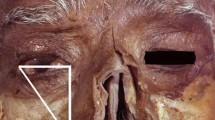Abstract
Purpose
This study aimed to investigate the anatomy of the infraorbital foramen (IOF), infraorbital canal (IOC), and infraorbital groove (IOG) with regard to surgical and invasive procedures using three-dimensional reconstruction of CT scans.
Methods
The CT scans of 100 patients were evaluated retrospectively. The morphology of the IOF, IOC, and IOG as well as their relationships to different anatomic landmarks was assessed in a three-dimensional model.
Results
The mean length of the IOC and IOG and the angle of the IOC relative to IOG were 11.7 ± 1.9, 16.7 ± 2.4 mm, and 145.5° ± 8.5°, respectively. The mean angles of the IOC relative to vertical and horizontal planes were 13.2° ± 6.4° and 46.7° ± 7.6°, respectively. In the relationships between the IOF and different anatomic landmarks, the mean distances from the IOF to supraorbital notch/foramen, facial midline, and infraorbital rim were 5.6 ± 3.1 mm laterally, 26.5 ± 1.9 mm laterally, and 9.6 ± 1.7 mm inferiorly, respectively. The mean distance from the IOF to anterior nasal spine (ANS) was 35.0 ± 2.6 mm, and the mean angle of the axis that passed the IOF and ANS relative to horizontal plane was 28.8° ± 4.1°. In addition, the mean soft tissue thickness overlying the IOF was 11.4 ± 1.9 mm.
Conclusions
These results provide detailed knowledge of the anatomical characteristics and clinical importance of the IOF. Such knowledge is of paramount importance for surgeons when performing maxillofacial surgery and regional block anesthesia.





Similar content being viewed by others
References
Abed SF, Shams PN, Shen S, Adds PJ, Uddin JM (2011) Morphometric and geometric anatomy of the Caucasian orbital floor. Orbit 30(5):214–220. doi:10.3109/01676830.2010.539768
Agthong S, Huanmanop T, Chentanez V (2005) Anatomical variations of the supraorbital, infraorbital, and mental foramina related to gender and side. J Oral Maxillofac Surg 63(6):800–804. doi:10.1016/j.joms.2005.02.016
Boopathi S, Chakravarthy Marx S, Dhalapathy SL, Anupa S (2010) Anthropometric analysis of the infraorbital foramen in a South Indian population. Singap Med J 51(9):730–735
Chrcanovic BR, Abreu MH, Custodio AL (2011) A morphometric analysis of supraorbital and infraorbital foramina relative to surgical landmarks. Surg Radiol Anat 33(4):329–335. doi:10.1007/s00276-010-0698-1
Chung MS, Kim HJ, Kang HS, Chung IH (1995) Locational relationship of the supraorbital notch or foramen and infraorbital and mental foramina in Koreans. Acta Anat (Basel) 154(2):162–166
Gupta T (2008) Localization of important facial foramina encountered in maxillo-facial surgery. Clin Anat 21(7):633–640. doi:10.1002/ca.20688
Higashizawa T, Koga Y (2001) Effect of infraorbital nerve block under general anesthesia on consumption of isoflurane and postoperative pain in endoscopic endonasal maxillary sinus surgery. J Anesth 15(3):136–138. doi:10.1007/s005400170014
Hwang SH, Seo JH, Joo YH, Kim BG, Cho JH, Kang JM (2011) An anatomic study using three-dimensional reconstruction for pterygopalatine fossa infiltration via the greater palatine canal. Clin Anat 24(5):576–582. doi:10.1002/ca.21134
Ji Y, Qian Z, Dong Y, Zhou H, Fan X (2010) Quantitative morphometry of the orbit in Chinese adults based on a three-dimensional reconstruction method. J Anat 217(5):501–506. doi:10.1111/j.1469-7580.2010.01286.x
Kahn DM, Shaw RB Jr (2008) Aging of the bony orbit: a three-dimensional computed tomographic study. Aesthet Surg J 28(3):258–264. doi:10.1016/j.asj.2008.02.007
Kazkayasi M, Ergin A, Ersoy M, Bengi O, Tekdemir I, Elhan A (2001) Certain anatomical relations and the precise morphometry of the infraorbital foramen–canal and groove: an anatomical and cephalometric study. Laryngoscope 111(4 Pt 1):609–614. doi:10.1097/00005537-200104000-00010
Lee UY, Nam SH, Han SH, Choi KN, Kim TJ (2006) Morphological characteristics of the infraorbital foramen and infraorbital canal using three-dimensional models. Surg Radiol Anat 28(2):115–120. doi:10.1007/s00276-005-0071-y
Levine RA, Garza JR, Wang PT, Hurst CL, Dev VR (2003) Adult facial growth: applications to aesthetic surgery. Aesthet Plast Surg 27(4):265–268. doi:10.1007/s00266-003-2112-4
Michalek P, Donaldson W, McAleavey F, Johnston P, Kiska R (2012) Ultrasound imaging of the infraorbital foramen and simulation of the ultrasound-guided infraorbital nerve block using a skull model. Surg Radiol Anat. doi:10.1007/s00276-012-1039-3
Molliex S, Navez M, Baylot D, Prades JM, Elkhoury Z, Auboyer C (1996) Regional anaesthesia for outpatient nasal surgery. Br J Anaesth 76(1):151–153
Rahman M, Richter EO, Osawa S, Rhoton AL Jr (2009) Anatomic study of the infraorbital foramen for radiofrequency neurotomy of the infraorbital nerve. Neurosurgery 64 (5 Suppl 2):423–427; discussion 427–428. doi:10.1227/01.neu.0000336327.10368.79
Richard MJ, Morris C, Deen BF, Gray L, Woodward JA (2009) Analysis of the anatomic changes of the aging facial skeleton using computer-assisted tomography. Ophthal Plast Reconstr Surg 25(5):382–386. doi:10.1097/IOP.0b013e3181b2f766
Saeedi OJ, Wang H, Blomquist PH (2011) Penetrating globe injury during infraorbital nerve block. Arch Otolaryngol Head Neck Surg 137(4):396–397. doi:10.1001/archoto.2010.239
Sharma N, De M, Pracy P (2007) Recurrent facial paraesthesia secondary to maxillary antral cyst and dehiscent infraorbital canal: case report. J Laryngol Otol 121(6):e6. doi:10.1017/s0022215107007785
Suresh S, Voronov P (2006) Head and neck blocks in children: an anatomical and procedural review. Paediatr Anaesth 16(9):910–918. doi:10.1111/j.1460-9592.2006.02018.x
Conflict of interest
All authors have no financial relationship concerning present study.
Author information
Authors and Affiliations
Corresponding author
Rights and permissions
About this article
Cite this article
Hwang, S.H., Kim, S.W., Park, C.S. et al. Morphometric analysis of the infraorbital groove, canal, and foramen on three-dimensional reconstruction of computed tomography scans. Surg Radiol Anat 35, 565–571 (2013). https://doi.org/10.1007/s00276-013-1077-5
Received:
Accepted:
Published:
Issue Date:
DOI: https://doi.org/10.1007/s00276-013-1077-5




